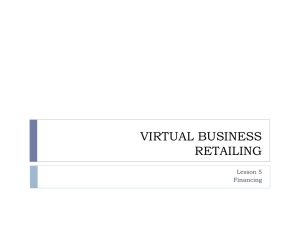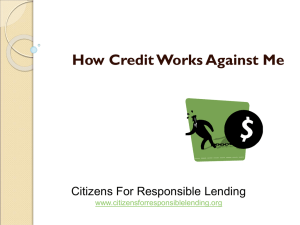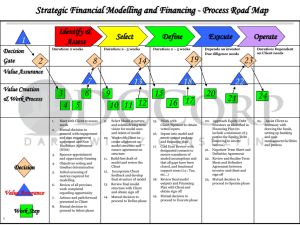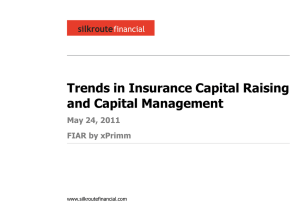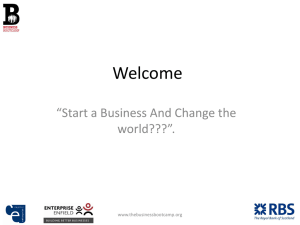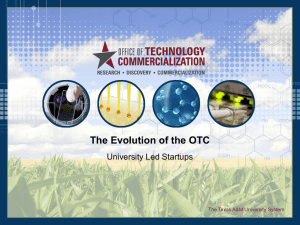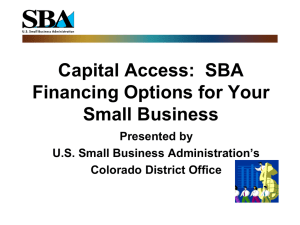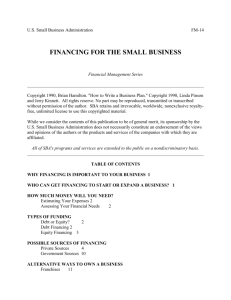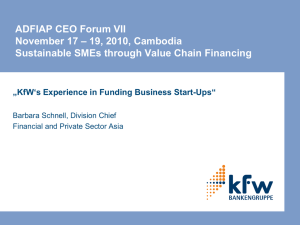Workshop Slides
advertisement
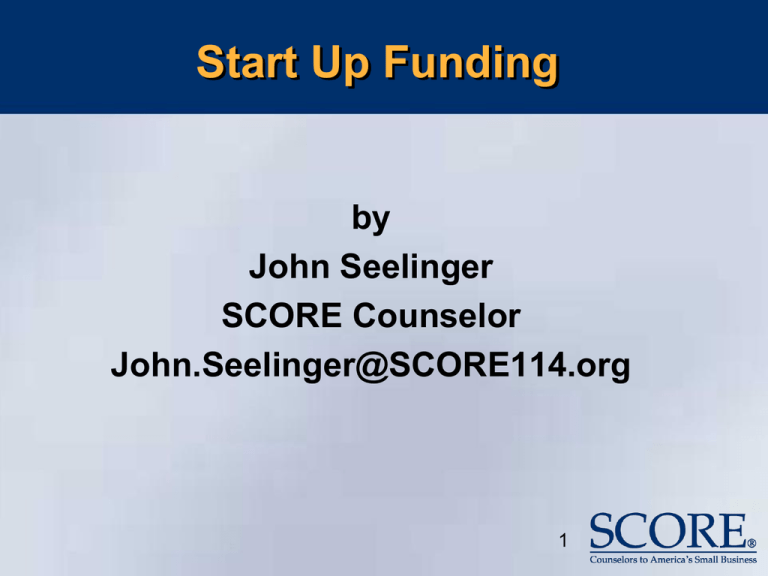
Start Up Funding by John Seelinger SCORE Counselor John.Seelinger@SCORE114.org 1 START UP COSTS • IF YOU DON’T HAVE ENOUGH CASH TO START YOUR BUSINESS RIGHT, WAIT UNTIL YOU CAN. • BUSINESS PLAN WILL HELP 2 Start Up Cost Estimates • Average Start Up Cost Estimates - $65K – Construction - $82K – Retail - $98K – Manufacturing - $175K -Babson College survey START-UP COSTS and CAPITAL SOURCES • START-UP CASH INVESTMENT FIXED CAPITAL INVESTMENTS • • • START UP GROWTH MAINTENANCE WORKING CAPITAL INVESTMENTS • • • START UP GROWTH MAINTENANCE CASH OUTLAYS UNTIL BREAKEVEN 4 START-UP COSTS and CAPITAL SOURCES • FIXED CAPITAL – How do you calculate how much your business needs at start-up and to maintain growth? Do not confuse the justification with how it will be financed. Justify first, then determine how to finance the investments. SALES FORECAST – 24 to 36 months How much “capacity” investment is required? How fast will you grow? New products or services? 5 START-UP COSTS and CAPITAL SOURCES • WORKING CAPITAL INVESTMENTS – The excess of current assets over current liabilities or the amount of cash required to fund the business on a day-to-day basis. An indication of short-term financial strength. Don’t be undercapitalized. • No business has ever failed because they had too much working capital. Working Capital = CURRENT ASSETS minus 6 CURRENT LIABILITIES START-UP COSTS and CAPITAL SOURCES • WORKING CAPITAL INVESTMENTS - How do you calculate how much your business needs at start-up and during periods of growth? SALES FORECAST – 24 to 36 months Working Capital increases and decreases with sales. It is a variable investment. Example: Figure $.20 increase for every incremental sales dollar increase. 7 CAPITAL SOURCES Does seed capital effect long-term profitability or growth rate? Only 65% of companies that started with more than $100,000 were in the black after one year compared with 83% of those businesses that were launched with $1,000 to $10,000.* *Inc Magazine 8 CAPITAL SOURCES • 42% of the Inc 500 CEOs surveyed had a formal business plan before the company was started • 31% are family owned • 17% have one or more offices overseas How start-ups are really funded: Self Financed 82% Loans from Family or Friends 22% Bank Loans 35% Private Equity, Venture Capital 8% 9 CAPITAL SOURCES • EQUITY FUNDING – Financing your business by selling a minority equity interest. This cash is less risky but more expensive. Valuation issues must be addressed. Initial and target valuation calculations must be made. 56% of founders started the company with a partner. 10 CAPITAL SOURCES Private Equity and Venture Capital Funding The average angel investor is between 48 and 59 years old, has a postgraduate degree, has experience in management and building a company, and typically invests between $25,000 and $250,000 per deal in one to four deals per year. 11 CAPITAL SOURCES Private Equity and Venture Capital funding Angel investors tend to like proprietary products and non-capital intensive businesses. They anticipate future rounds of financing. Angel investors look for: 1. Market niches – potential to dominate or be #1 or #2 in the industry 2. Advanced technology and a disruptive model (going to change things) 3. Compelling and sustainable advantage – not “me too” 4. Planned exit in 4-6 years 5. Reasonable valuation 6. Performance equal to 5 -10 times original investment 7. ROI equal to 20-40% per year 8. Sitting on your board but not having control 9. Higher risk business models 10. Angels spend, on average, 51 hours on due diligence per investment 12 CAPITAL SOURCES BANK LOANS or DEBT FINANCING Banks typically will loan 2.5 – 4.0 times Cash Flow – usually based on EBITDA. Banks would like to see a 3-5 year track record or a history of business experience Debt is less expensive but more risky than equity Banks will not lend on pure projections: You must have a history of cash flow or a current personal guarantee. Three sources of repayment: 1. 2. 3. 4. 5. • • • Cash Flow Liquidation value of assets 13 Personal Guarantees of each 25% equity owner CAPITAL SOURCES NEGATIVES TO A BANKER 1. 2. 3. 4. 5. 6. 7. 8. 9. Getting involved with something outside your normal business model Absentee management / ownership Divorce Burnout Growing beyond owner’s capacity to operate the business Parent turns over business to son or daughter Computer conversions Relocation and / or expansion of facility Companies “hit the wall” at: 1. Manufacturing companies at $2 million in sales 2. Distribution companies at $4 million in sales 3. Retailers at 3 stores and distance 4. Service companies at 12 employees 5. Contractors at 2 or more big jobs 14 CAPITAL SOURCES A bank would rather see a 640 FICO score with all payments as agreed (no late payments, foreclosures, repossessions, charge offs or collection accounts) than a 740 FICO score with a past foreclosure, and three previously delinquent accounts now paid. Having a stable source of income to meet personal income requirements can be a significant factor in reducing business risk for a start-up. 15 CAPITAL SOURCES QUESTIONS A BANKER WILL ASK YOU 1. 2. 3. 4. 5. 6. 7. 8. 9. 10. Do you have a Business Plan? How much experience do you have in this industry? How is your credit and how much personal debt do you have? How much is your down payment? Is it at least 25%? How much collateral do you have? Who is the competition? Do you have personal and business insurance? Do you have services of an accountant and attorney? Have you ever filed for bankruptcy? Do you have 2-4 years of tax returns available? 16 CAPITAL SOURCES SMALL BUSINESS ADMINISTRATION (SBA) The SBA does not loan money. It guarantees (to the bank) approximately 85% of the loan proceeds to you. Five to ten year payback terms. Interest rates of prime plus 2 – 4% depending on the program and terms. This reduces the banker’s risk, thereby enabling the loan to be approved. They use basic credit standards: – – – – – – Character Management ability Cash Flow Equity Feasible Business Plan Sufficient collateral 17 CAPITAL SOURCES SBA ELIGIBILITY (There are exceptions) • Must be “for profit” • Must be an operating company. SBA does not allow speculation or investment companies. • Must be a small business: – Manufacturing – Wholesaling – Services 500 -1,000 employees less than 100 employees Receipts test for each classification 18 CAPITAL SOURCES • • • • • SBA ELIGIBILITY Cannot be a business in lending, life insurance, real estate development or rental property. Gambling, promoting religion, pyramid sales plans, consumer marketing cooperatives and persons of poor character are ineligible. Individuals must be lawfully in the U.S. Business cannot be located outside the U.S. Import businesses may be ineligible Go to www.SBA.gov for a complete list of ineligible businesses. Also, a good resource for minority and micro-loan plans. 19 EXIT Many of the CEO’s plan to cash out. 41% of CEO’s started the company with at least one exit strategy in mind. Some had several. Those strategies included: Going Public: 47% Selling to a private buyer: 80% Leaving the company to heirs: 7% 20 CAPITAL SOURCES MISTAKES ENTREPRENEURS MAKE WHEN RAISING CAPITAL Don’t understand share prices or valuations Confuse broad market with served market Make unrealistic assumptions about an exit strategy Don’t understand long term capital needs Have no clue about competition Don’t understand that marketing beats technology 9 out of 10 times 7. Write a poor executive summary 1. 2. 3. 4. 5. 6. 21 CAPITAL SOURCES MISTAKES ENTREPRENEURS MAKE WHEN RAISING CAPITAL 8. Use “off the wall” numbers or pull numbers from thin air 9. Lack focus; e.g. many products or niches 10. Develop too simplistic of a market plan / analysis 11. Underestimate expenses 12. Rely on financial plans with major inconsistencies; e.g. numbers don’t match or tie 13. Speak in “techno-jargon”. No one understands what they are saying 22 CAPITAL SOURCES BEST WAYS TO IRRITATE AN INVESTOR 1. Lying to investors or not being forthright; omission of material information 2. Inability to answer direct questions with direct answers 3. Surprises; e.g. problem with credit checks, hidden liabilities or debts 4. Over hype or exaggerate upside 5. Your story always changes 6. Arguing with investors 7. Late for meetings 8. Excessive secrecy or legalese; expect investor to sign NDA 9. Investing capital in fancy facility and furniture 23 10. Fail to attract top talent CAPITAL SOURCES LEASE FINANCING Many start-ups may want to consider lease financing for their fixed capital needs. Leasing sometimes shifts the risk of ownership, such as technological obsolescence onto the lessor thus freeing the lessee to finance working capital needs. There also may be possible tax advantages in certain cases that makes leasing less expensive on an after-tax basis. 24 Capital Sources • ROYALTY FINANCING: • basically loaning money against the promise of a future sales. The lender collects a portion of the gross revenue on a monthly or quarterly basis until an agreed to total amount is paid back, usually 4 times the original loan amount. This works with companies that are pre-revenue and are just at the point that they can begin to make sales but need financing to buy inventory or materials for manufacturing or need to invest in key marketing expenses to fuel their revenue machine. The companies cannot usually borrow from traditional lenders because they lack a documented means to pay the loan back (historic sales), may have been in business less than 2 years, and do not have collateral to secure the note. Capital Sources (Royalty Financing cont’d) • Often the valuation for a company at this stage is relatively low compared to their potential once fully operational; therefore any equity investment would take a substantial amount of equity. Companies that fit this model tend to have high margins and non-cash transactions. Example: Terralink Software Systems, of Maine, needed to turbocharge its sales and marketing efforts of its PC based software products. Terralink was selling their product and having moderate growth. The founders felt that an infusion of $200K could get them to their target of $750K in sales and repeat customer sales transactions. However, they did not want to give up a substantial part of their equity for that money. A $200K loan against future sales seemed ideal. Capital Sources (Royalty Financing cont’d) • In exchange for this “advance”, the investors received 3% of Terralink’s sales for 10 years or until they received payments totaling $600,000. This amount would represent the original $200,000 investment plus $400,000 more. If Terralink repaid the advance over 10 years, investors would earn a compound annual return of 11.6% or their investment. If however, Terralink’s sales took off and the $600,000 was paid to the investors in five years, the compound annual return would be a juicy 24.5%. Capital Sources • Asset Based Lending • Factoring Good To Know Websites • • • • • • • • SBA.Gov Score.org Score114.org Rjbradley.com/blog Business.gov Grants.gov Prosper.com Boefly.com More Websites “Crowd Funding” – Profounder.com – Peerbackers.com – Kickstarter.com – Indiegogo.com – Rockethub.com QUESTIONS ? SCORE JOHN SEELINGER John.Seelinger@SCORE114.org 31
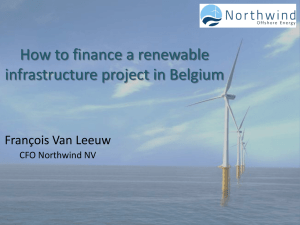
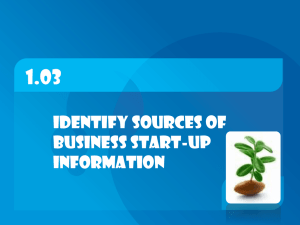

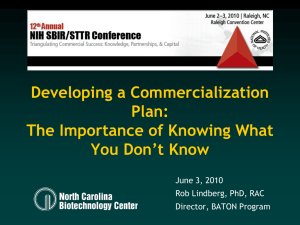
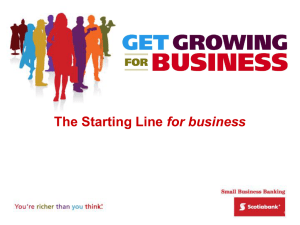
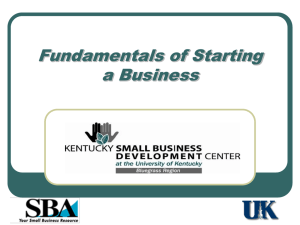
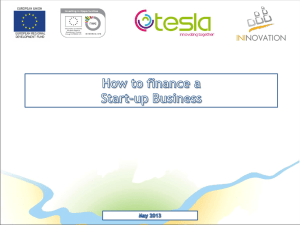
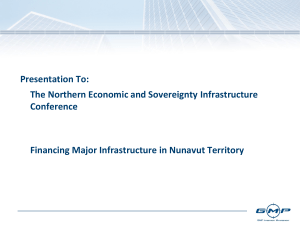
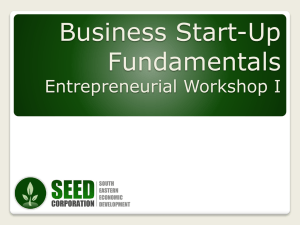
![[07]. Sources of Capital](http://s2.studylib.net/store/data/005505954_1-911bc72c2d6c6cd967dc43c95f25b7bd-300x300.png)
